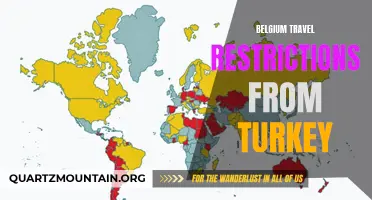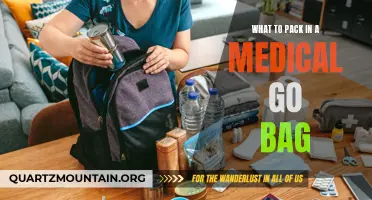
In times of crisis or natural disasters, being prepared for an evacuation is crucial. Whether it's a hurricane, wildfire, or other emergency situation, having essential items packed and ready to go can make all the difference. From food and water to important documents and first aid supplies, being prepared ensures that you can focus on your safety and the safety of your loved ones. In this article, we will explore the essential items to pack for an evacuation, so you can be prepared for the unexpected and navigate through difficult times with ease.
| Characteristics | Values |
|---|---|
| Food | Non-perishable items such as canned goods, granola bars, and dried fruit. Don't forget a manual can opener! |
| Water | At least one gallon of water per person per day for at least three days, including for drinking and sanitation. |
| Clothing | A change of clothes for each person, including sturdy shoes and a jacket in case of cold weather. |
| Bedding | Sleeping bags or blankets for each person. |
| Medications | A supply of any prescription medications needed for at least a week. |
| First Aid Kit | A well-stocked first aid kit including bandages, antibiotic ointment, and pain relievers. |
| Personal Hygiene | Items such as toilet paper, soap, toothbrushes, and feminine products. |
| Important Documents | Copies of important documents such as identification, insurance policies, and medical records. |
| Cash | Small bills and coins, as ATMs may not be accessible during an evacuation. |
| Flashlights | Battery-powered or hand-crank flashlights in case of power outages. |
| Radio | A battery-powered or hand-crank radio to stay informed about updates and alerts. |
| Cellphone Charger | A portable cellphone charger or extra battery pack. |
| Whistle | A whistle to signal for help if needed. |
| Maps | Local maps in case of detours or unfamiliar routes. |
| Pet Supplies | Food, water, leash, and any necessary medications for pets. |
| Entertainment | Books, games, or other forms of entertainment to pass the time. |
What You'll Learn
- What essential documents and identification should be included in an evacuation pack?
- What types of clothing and personal items are recommended to have in an evacuation bag?
- Are there any specific items or supplies that should be packed for infants or young children during an evacuation?
- Should any non-perishable food and water be included in an evacuation pack, and if so, how much?
- What tools or equipment are important to have in an evacuation bag for emergency situations?

What essential documents and identification should be included in an evacuation pack?

In the event of an emergency or natural disaster, having an evacuation pack ready can make all the difference in ensuring the safety and well-being of yourself and your loved ones. One crucial aspect of preparing for such situations is gathering and organizing essential documents and identification that may be needed during the evacuation process. Here, we will discuss the important items that should be included in an evacuation pack.
Identification Documents:
It is vital to have copies of identification documents for every member of your household. These include birth certificates, passports, driver's licenses, and social security cards. These documents will be necessary for verifying identity, accessing medical care, and even applying for emergency assistance in the aftermath of a disaster.
Financial Documents:
Including copies of important financial documents is crucial in an evacuation pack. These documents may include bank account information, credit card information, and copies of insurance policies, including health, auto, and homeowners insurance. These documents will allow you to access funds, file insurance claims, and address any financial matters that may arise during the evacuation.
Medical Records:
Having copies of medical records is essential, especially for individuals with chronic conditions or specific medical needs. These records should include a list of medications, dosages, and instructions, as well as any relevant medical history. In the event of an evacuation, having access to this information can help medical professionals provide adequate care, even if they are unfamiliar with your medical history.
Contact Information:
It is crucial to have a list of emergency contact information for yourself and for each member of your household. This should include phone numbers of family members and close friends, as well as your doctor's contact information. Additionally, including a list of important organizations, such as your employer's contact information or your child's school, can be helpful in keeping everyone informed and connected during the evacuation.
Other Essential Documents:
There are several other documents that should be included in your evacuation pack. These may include copies of important legal documents, such as wills, power of attorney documents, and property deeds. It is also wise to include a current inventory of your home's contents, complete with photographs or videos, to assist with insurance claims in the event of damage or loss. Finally, consider adding any necessary personal documents, such as pet ownership records or vaccination records, if applicable.
Organizing Your Evacuation Pack:
To ensure easy access and protect these essential documents, store them in a waterproof and fireproof container. You can also use resealable plastic bags to further protect each document from water damage. Keep the container in a designated place that is easily accessible, and make sure all members of your household know where it is located.
In conclusion, when preparing an evacuation pack, it is crucial to include essential documents and identification that may be required during a disaster. By gathering and organizing copies of identification documents, financial documents, medical records, contact information, and other relevant paperwork, you can better protect yourself and your loved ones during an emergency. Remember to regularly update these documents and inform your family members of their existence and location. Being prepared can provide peace of mind and ensure a smoother process in the event of an evacuation.
Essential Items to Pack for Backpacking in Mexico
You may want to see also

What types of clothing and personal items are recommended to have in an evacuation bag?

In the event of an emergency or natural disaster, it is important to be prepared and have an evacuation bag ready to go. Your evacuation bag should contain essential clothing and personal items that will help you stay safe, comfortable, and prepared during an evacuation. Here are some recommendations for items to include in your evacuation bag:
Clothing:
- Several changes of clothes: It is important to have enough clothes to last for several days. Pack comfortable, lightweight clothing that can be easily layered for warmth or removed if it gets too hot.
- Undergarments: Pack enough underwear and socks for each day you anticipate being away from home.
- Sturdy shoes: Include a pair of comfortable shoes that can handle various terrains. You may need to walk long distances or navigate through debris during an evacuation.
- Rain gear: Be prepared for inclement weather by including a raincoat or poncho in your bag. This will keep you dry and protect your clothing from getting wet.
- Hat and sunglasses: These items will provide protection from the sun and any glare that may hinder your vision during an evacuation.
Personal Items:
- Toiletries: Pack essential toiletries such as toothbrush, toothpaste, soap, shampoo, and any medications you regularly take. These items will help you maintain personal hygiene during an evacuation.
- First aid kit: Including a basic first aid kit in your evacuation bag is crucial. It should contain band-aids, antiseptic ointment, pain relievers, and any necessary prescription medications.
- Personal documents: Include copies of important documents such as identification cards, passports, insurance policies, and any other necessary legal or financial documents. It is also a good idea to have a USB drive with digital copies of these documents.
- Cash and/or credit cards: In case ATMs are inaccessible during an evacuation, having some cash on hand can be useful. Additionally, having a credit card as a backup form of payment is recommended.
- Flashlight and batteries: A flashlight will come in handy if you find yourself in a dark area or without power. Make sure to pack extra batteries as well.
- Cell phone and charger: Keep your cell phone fully charged and include a portable charger or extra batteries in your bag. This will allow you to stay connected and potentially call for help if needed.
Additional Items:
- Emergency blanket: Include a lightweight emergency blanket that can provide warmth and shelter if necessary.
- Multi-tool: Having a multi-tool with a knife, scissors, and other practical tools can be handy in various situations.
- Whistle: A whistle can be used to attract attention or signal for help.
- Food and water: Pack non-perishable food items and bottled water to sustain yourself for at least a few days. These items should be regularly rotated to ensure they remain fresh.
Remember to periodically check and update the items in your evacuation bag to ensure everything is in working order and up-to-date. It is also a good idea to have a plan in place for where you will go and who you will contact in the event of an evacuation. By being prepared and having a well-stocked evacuation bag, you can minimize stress and increase your chances of safely navigating through an emergency situation.
Essential Items to Pack for a Toddler Vacation
You may want to see also

Are there any specific items or supplies that should be packed for infants or young children during an evacuation?

When preparing for an evacuation, it is important to consider the needs of infants and young children. They require specific supplies and items to ensure their safety and well-being during the evacuation process. In this article, we will discuss the essential items and supplies that should be packed for infants and young children during an evacuation.
- Diapers and wipes: Infants and young children often require diapers and wipes for their daily hygiene needs. It is crucial to pack an adequate supply of diapers and wipes to last through the duration of the evacuation. Consider the number of diapers typically used by your child in a day and multiply it by the number of days you anticipate the evacuation to last.
- Formula and baby food: If your child is not exclusively breastfed, it is important to pack an ample supply of formula or baby food to meet their nutritional needs. Ensure that you have enough formula and baby food to last throughout the evacuation. Consider packing single-serving packets or pre-measured formula to simplify preparation during the evacuation.
- Bottles and feeding supplies: Pack enough bottles, nipples, and feeding supplies to ensure your child can be fed properly during the evacuation. Consider bringing additional bottles in case some get lost or damaged. It is also advisable to pack a bottle brush and dish soap for cleaning bottles and feeding supplies.
- Medications and first aid supplies: If your child requires any medications, be sure to pack an adequate supply. Keep medications in their original packaging and include any necessary instructions or prescriptions. Additionally, pack a basic first aid kit with essentials such as band-aids, antiseptic wipes, thermometer, and children's pain relief medication.
- Comfort items: During an evacuation, it is important to provide comfort and familiarity to infants and young children. Consider packing their favorite stuffed animal, blanket, or other comfort items that they rely on for security. These items can help provide comfort and reduce anxiety during a stressful situation.
- Baby carrier or stroller: Depending on the age and mobility of your child, a baby carrier or stroller can be a useful item to have during the evacuation. They can be used to transport your child safely and make moving through crowded areas or uneven terrain easier.
- Clothing and bedding: Pack enough clothing, including spare outfits, pajamas, socks, and hats, to last throughout the evacuation. Be mindful of the weather conditions and pack appropriate clothing for warmth or protection from the elements. Additionally, bring a lightweight portable crib or travel bed if your child requires a specific sleeping arrangement.
- Personal care items: Don't forget to pack personal care items for your child, such as baby shampoo, lotion, diaper rash cream, and sunscreen. These items are essential for maintaining your child's hygiene and protecting their delicate skin.
Remember to review and update your child's supplies regularly to ensure that everything is current and suitable for their needs. Additionally, keep important documents, such as medical records and identification, readily accessible in case of emergency.
In conclusion, when preparing for an evacuation, it is crucial to consider the specific needs of infants and young children. Diapers, formula, bottles, medication, comfort items, clothing, and personal care items are all essential supplies to pack. By ensuring that you have these items readily available, you can help provide for the needs and well-being of your child during an evacuation.
Aer Lingus: What You Can't Pack in Your Luggage
You may want to see also

Should any non-perishable food and water be included in an evacuation pack, and if so, how much?

In emergency situations, such as natural disasters or civil unrest, it is crucial to have an evacuation pack prepared in case you and your family need to leave your home quickly. One key component of an evacuation pack is non-perishable food and water. These items can provide sustenance during the evacuation and may be necessary if access to food and water is limited or unavailable at your destination.
When considering what types of food to include in your evacuation pack, it is important to choose items that have a long shelf life and do not require refrigeration. Canned goods, dried fruits, nuts, and granola bars are excellent options. These foods are lightweight, compact, and provide a good source of calories and nutrients. It is advisable to include a variety of foods to cater to different dietary preferences and restrictions within your family.
Water is another essential item to include in your evacuation pack. The general rule of thumb is to have one gallon of water per person per day. This estimate takes into account hydration needs, as well as water for basic hygiene purposes. It is important to store water in appropriate containers that are sealed and made from food-grade materials. Additionally, consider including water purification tablets or a portable water filter in your pack, as these can be helpful if you run out of stored water or need to collect water from non-potable sources.
The amount of non-perishable food and water to include in your evacuation pack will vary depending on the size of your family, the duration of the evacuation, and your individual needs. It is recommended to have at least three days' worth of food and water for each person. This timeframe allows for temporary disruptions in food and water supply, as well as any delays in reaching a safe location.
To determine the exact quantities of food and water to pack, consider the following factors:
- Family Size: Take into account the number of adults and children in your family. Adjust the quantities accordingly to ensure everyone has enough sustenance during the evacuation.
- Duration of Evacuation: If you live in an area prone to longer-term disasters, such as hurricanes or flooding, it may be wise to have a week or more of food and water on hand.
- Special Considerations: If any family members have specific dietary needs or medical conditions, make sure to include food that meets their requirements. It is always better to be over-prepared than under-prepared in such cases.
- Storage Space: Consider the available space in your evacuation pack and the weight you can comfortably carry. Opt for lightweight and compact food and water options, considering their nutritional value.
Lastly, it is important to regularly check the expiration dates of the food and water in your evacuation pack and rotate them out as needed. Remember to also include a manual can opener, utensils, and any essential cooking equipment, if necessary.
In conclusion, including non-perishable food and water in your evacuation pack is crucial for ensuring the well-being of you and your family during emergency situations. The exact quantity will vary based on your family size, the duration of the evacuation, and individual needs. By following the guidelines mentioned above and including a variety of food options, you can be prepared to face any unforeseen circumstances that may arise.
Essential Tips for Packing for a Caribbean Cruise
You may want to see also

What tools or equipment are important to have in an evacuation bag for emergency situations?

In emergency situations, it is important to have an evacuation bag ready to grab at a moment's notice. This bag should contain essential tools and equipment that will help you navigate through the crisis and ensure your safety. Here are some important items that should be included in an evacuation bag for emergency situations:
- First Aid Kit: A well-stocked first aid kit is crucial in emergency situations. It should include items such as bandages, gauze pads, adhesive tape, antiseptic wipes, pain relievers, and any necessary prescription medications. Additionally, it is advisable to include a first aid manual to guide you in providing basic medical care.
- Water and Food: It is important to have a sufficient supply of water and non-perishable food items in your evacuation bag. Aim for at least one gallon of water per person per day, and include food that does not require cooking or refrigeration. This can include granola bars, canned goods, trail mix, and dried fruits. Don't forget to pack a manual can opener if necessary.
- Flashlight and Batteries: In emergency situations, it is common for power outages to occur. Therefore, having a flashlight with extra batteries is essential. Opt for LED flashlights, as they are more energy-efficient and have a longer battery life. It is also a good idea to have spare batteries in various sizes to ensure you can power other essential devices.
- Portable Phone Charger: Keeping your phone charged is crucial in emergencies, as it allows you to communicate with emergency services and loved ones. A portable phone charger or a power bank with a USB port can keep your phone powered when access to electricity is limited.
- Multi-tool: A multi-tool is a versatile piece of equipment that can come in handy in various emergency situations. It typically includes features such as knives, screwdrivers, pliers, and wire cutters. This tool can be useful for minor repairs, building temporary shelters, or opening canned food.
- Emergency Radio: An emergency radio with a built-in weather alert can provide you with crucial information during an evacuation. Look for a radio that operates on a hand crank or solar power to ensure it works even when batteries are not available.
- Personal Protective Equipment: In some emergency situations, you may encounter hazards such as smoke, dust, or debris. It is important to have personal protective equipment such as dust masks, safety goggles, and work gloves to protect yourself from these potential dangers.
- Copies of Important Documents: Having copies of important documents such as identification cards, passports, insurance policies, and medical records can be valuable in emergency situations. Store these copies in a waterproof container or a sealed plastic bag to protect them from water damage.
- Cash: In situations where electronic payment methods are not available, having a small amount of cash in your evacuation bag can be useful for purchasing supplies or services when needed.
- Extra Clothing and Blankets: Pack a change of clothes suitable for the climate in your area, as well as extra socks and underwear. Additionally, including a lightweight blanket can provide warmth and comfort during an evacuation.
Remember, the contents of an evacuation bag may vary depending on the specific needs and circumstances of an individual or family. It is important to regularly review and update your bag to ensure its contents remain relevant and usable. Additionally, consider the specific hazards and risks in your area when selecting equipment for your evacuation bag. Following these guidelines will help ensure you are prepared for various emergency situations and can evacuate safely if necessary.
Essential Things to Pack for Your Trip to Cartagena
You may want to see also
Frequently asked questions
It is important to have essential items packed in your emergency evacuation bag. Some of these items include a first aid kit, non-perishable food and water, a flashlight, batteries, a backup phone charger, a portable radio, extra clothes and blankets, personal hygiene items, important documents, cash, and any necessary medications. It is also recommended to have a spare set of car keys and a map of the area in case GPS or phone service is not available.
When preparing for an emergency evacuation, it is crucial to pack enough food and water to sustain you and your family for at least three days. The general rule of thumb is to pack one gallon of water per person per day. For food, choose non-perishable items such as canned goods, granola bars, and dried fruits that have a long shelf life. It is recommended to have enough food and water to last up to a week in case the evacuation period is prolonged.
When packing items for infants, elderly individuals, or those with special needs, it is essential to consider their specific requirements. This may include packing extra diapers, formula or baby food for infants, any necessary medical supplies, mobility aids, or assistive devices for the elderly or individuals with disabilities. It is also important to have a plan in place to ensure their safety during evacuation, such as identifying accessible evacuation routes or contacting local authorities for assistance.







